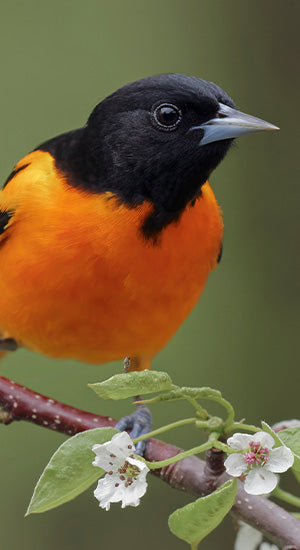Winter Preparation For Your Pond

Prepping Your Pond
Prepping your pond for Winter is the best done in the Autumn. Take time to clean it out before water temperatures fall below 50°F. For Southwestern Ontario this is typically between mid September and early October. Cleaning before the water has cooled too much helps prevent injury to your fish, since they are still active.
Scoop up fallen leaves from the surface with a fine net. You may want to pump some of the water out of the pond to expose any planting shelves around the pond periphery. Many leaves get stuck in and around rocks in this area, making them hard to get without using your hands. Once you have removed as many leaves as possible, use a hose nozzle or pressure washer and blast off the accumulated debris and sludge around the pond shelves and edges. Remove remaining debris with a very fine net, or pond vacuum. Replace the water after cleaning, remembering to add the necessary amount of water conditioner to remove chlorine, chloramine, and heavy metals from the water.
You may opt to do a 20% water change at this point to give a clean, fresh start to your pond for Winter season ahead.
Once The Pond Is Clean
If you are planning on adding a large net over the pond, now is the time. Ensure the net is well fastened around the edges, leaves and debris may work their way underneath of a poorly secured covering. Please note that frogs and similar wildlife may still travel to and from your pond, leaving a few small openings is recommended. Suspend the net 18" - 24" above the surface of the pond to prevent the net from sagging into the water. This creates risk for the fish, as well as allowing the leaves to decay in the water - everything you've been working to prevent! If you notice the net is getting weighed down with leaves, you may need to use a leaf blower or other tool to clear some off and reduce the weight on the net.
Don't Forget The Plants!
Plants you've intentionally added to your pond can become a source of debris. Hardy plants like waterlilies and rushes will die back as the days shorten and the temperature drops. Trimming them back before the water freezes will not cause harm to the plant and allows you to keep as much debris out of your water as possible. Ensure your container-grown waterlilies are at a depth which prevents the growing media from freezing (typically 2 feet is recommended). Container grown marginal plants should be treated similarly, just ensure that they don't freeze more than 1" - 2" deep. If you have planted your marginals directly around the pond, use straw or leaf litter to insulate them.
It is recommended to remove non-hardy aquatic plants like Water Hyacinths or Tropical Lilies from the water after the first frost or when they become visually unappealing. With the correct care, tropical lilies can be overwintered indoors to be enjoyed in your pond (when it's warm) for many years to come!
Closing The Pond For Winter
The first step is to determine when you should shut down your pond's equipment; the pump, the filter and the UV clarifier. While some people may want to keep these running to keep the water open, that may not be the best choice. Water at the surface will be notably cooler than water deeper in the pond. Running the pump will mix this colder surface water with the warmer, more stable temperatures in the deepest parts of your pond, which where fish take comfort and hibernate. In addition to this, there is a risk of diverting water out of the pond by accident, which could empty your pond below the ice surface and you may not even know it. As ice forms on rocks, ledges, and other features and contours of your pond, water may not flow as intended, and could be sent away from your pond.
Water freezing in your equipment, or even the hoses between them, can cause significant damage to your pumps, filters, and more. It is recommended that pond keepers store their equipment indoors safe from the elements. This is a great opportunity to assess the condition of your equipment, clean it, and replace any parts necessary. If you are storing your pumps, filters or any other equipment outdoors or in an unheated space, make sure that there is no water left in the device that may ice up and cause the machine to break. If kept inside it helps to place the pump, if it is submersible, in a bucket of water to keep the moving parts and seals wet.
Winter Pond Equipment
Gases, which are produced by decomposing organic material, are toxic to fish when they are trapped beneath the ice that is covering the pond’s surface. De-icer’s are designed to keep an area of the pond ice-free during the winter, allowing harmful gases to escape through the opening. In small ponds, a de-icer is especially helpful in preventing ponds from freezing solid. For fish safety, it is extremely important to never break ice on the pond because the shock waves can be detrimental, and sometimes fatal, to fish.
Remember, winter can be stressful on a fish’s immune system. De-icers alleviate stress during the winter, making it easier for them to withstand diseases that are more prevalent in the spring. Another option is using an Air Pump to move a water column to keep ice from forming above on the surface. Please read the instructions for the pump you chose; many are not designed to run the air stone from the bottom of the pond. If run outside of the manufacturer guidelines, you WILL shorten the life of the equipment. This also mixes the water temperatures and is not a healthy choice for the fish in the pond.
Run the stone around the 24” mark to keep things running smooth all winter. Placement of the pond heater or air pump should be in an area out of the prevailing winds to maximize the working capacity. The best set up is with the heater and the air working in the same area as both will benefit from this relationship. A tip that helps with the electrical setup is using a GFCI breaker or electrical plug. You can also include an LED light in the system to know the electricity is running to the pond!
Caring & Feeding Fish During Winter
In Canada, it’s best to leave fish in the pond during the winter, providing the depth of the pond is adequate (30˝ or deeper) and there is little or no water circulation. The denser, warmer water will sink to the bottom of the pond where it will be insulated by the cooler surface water or ice and fish will gather in this deep, warm area. It’s important that some types of fish, such as fancy Goldfish with ornate tails, bubble eyes and lionheads should be brought indoors as they are sensitive to colder weather.
Purchase a Wheat Germ-based pond food developed especially for a spring/fall (Sept on) diet and use it in early fall to get your fish ready for the winter season. As winter approaches, pond keepers should monitor water temperatures daily. When the water temperature falls below 50°F, pond keepers should stop feeding the fish altogether. First time pond keepers may worry about not feeding their fish, but you can assure them that their fish will naturally rely on stored energy reserves to sustain them throughout the winter months.
Fall/Winter Pond Prep Checklist
- Reduce the number of leaves falling into the pond with netting or remove them with a pond net
- Clean out the pond as outlined above
- Cut back dead or dying aquatic plant foliage during the fall
- Purchase a Wheat Germ-based pond food developed especially for a spring and fall Diet
- Disconnect the pump, filter and UV clarifier before water freezes
- Store UV clarifier indoors for protection
- Store filters indoors (if manufacturer’s directions suggest)
- Purchase or have the pond de-icer ready for installation (needed for everyone that has a pond in Canada)










